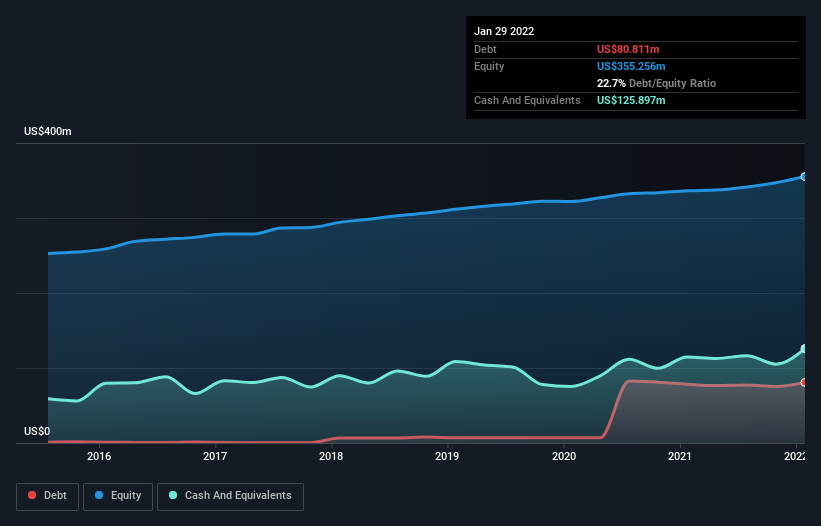These 4 Measures Indicate That Village Super Market (NASDAQ:VLGE.A) Is Using Debt Reasonably Well
David Iben put it well when he said, 'Volatility is not a risk we care about. What we care about is avoiding the permanent loss of capital.' It's only natural to consider a company's balance sheet when you examine how risky it is, since debt is often involved when a business collapses. We note that Village Super Market, Inc. (NASDAQ:VLGE.A) does have debt on its balance sheet. But the more important question is: how much risk is that debt creating?
Why Does Debt Bring Risk?
Debt assists a business until the business has trouble paying it off, either with new capital or with free cash flow. Part and parcel of capitalism is the process of 'creative destruction' where failed businesses are mercilessly liquidated by their bankers. However, a more common (but still painful) scenario is that it has to raise new equity capital at a low price, thus permanently diluting shareholders. Of course, debt can be an important tool in businesses, particularly capital heavy businesses. When we examine debt levels, we first consider both cash and debt levels, together.
See our latest analysis for Village Super Market
What Is Village Super Market's Net Debt?
As you can see below, Village Super Market had US$80.8m of debt, at January 2022, which is about the same as the year before. You can click the chart for greater detail. But it also has US$125.9m in cash to offset that, meaning it has US$45.1m net cash.
A Look At Village Super Market's Liabilities
Zooming in on the latest balance sheet data, we can see that Village Super Market had liabilities of US$157.0m due within 12 months and liabilities of US$385.0m due beyond that. On the other hand, it had cash of US$125.9m and US$41.5m worth of receivables due within a year. So its liabilities total US$374.6m more than the combination of its cash and short-term receivables.
When you consider that this deficiency exceeds the company's US$341.4m market capitalization, you might well be inclined to review the balance sheet intently. Hypothetically, extremely heavy dilution would be required if the company were forced to pay down its liabilities by raising capital at the current share price. Village Super Market boasts net cash, so it's fair to say it does not have a heavy debt load, even if it does have very significant liabilities, in total.
Also positive, Village Super Market grew its EBIT by 28% in the last year, and that should make it easier to pay down debt, going forward. There's no doubt that we learn most about debt from the balance sheet. But it is Village Super Market's earnings that will influence how the balance sheet holds up in the future. So if you're keen to discover more about its earnings, it might be worth checking out this graph of its long term earnings trend.
But our final consideration is also important, because a company cannot pay debt with paper profits; it needs cold hard cash. Village Super Market may have net cash on the balance sheet, but it is still interesting to look at how well the business converts its earnings before interest and tax (EBIT) to free cash flow, because that will influence both its need for, and its capacity to manage debt. During the last three years, Village Super Market produced sturdy free cash flow equating to 70% of its EBIT, about what we'd expect. This cold hard cash means it can reduce its debt when it wants to.
Summing up
While Village Super Market does have more liabilities than liquid assets, it also has net cash of US$45.1m. And we liked the look of last year's 28% year-on-year EBIT growth. So we don't have any problem with Village Super Market's use of debt. When analysing debt levels, the balance sheet is the obvious place to start. However, not all investment risk resides within the balance sheet - far from it. For instance, we've identified 2 warning signs for Village Super Market (1 makes us a bit uncomfortable) you should be aware of.
If, after all that, you're more interested in a fast growing company with a rock-solid balance sheet, then check out our list of net cash growth stocks without delay.
Have feedback on this article? Concerned about the content? Get in touch with us directly. Alternatively, email editorial-team (at) simplywallst.com.
This article by Simply Wall St is general in nature. We provide commentary based on historical data and analyst forecasts only using an unbiased methodology and our articles are not intended to be financial advice. It does not constitute a recommendation to buy or sell any stock, and does not take account of your objectives, or your financial situation. We aim to bring you long-term focused analysis driven by fundamental data. Note that our analysis may not factor in the latest price-sensitive company announcements or qualitative material. Simply Wall St has no position in any stocks mentioned.

 Yahoo Finance
Yahoo Finance 
